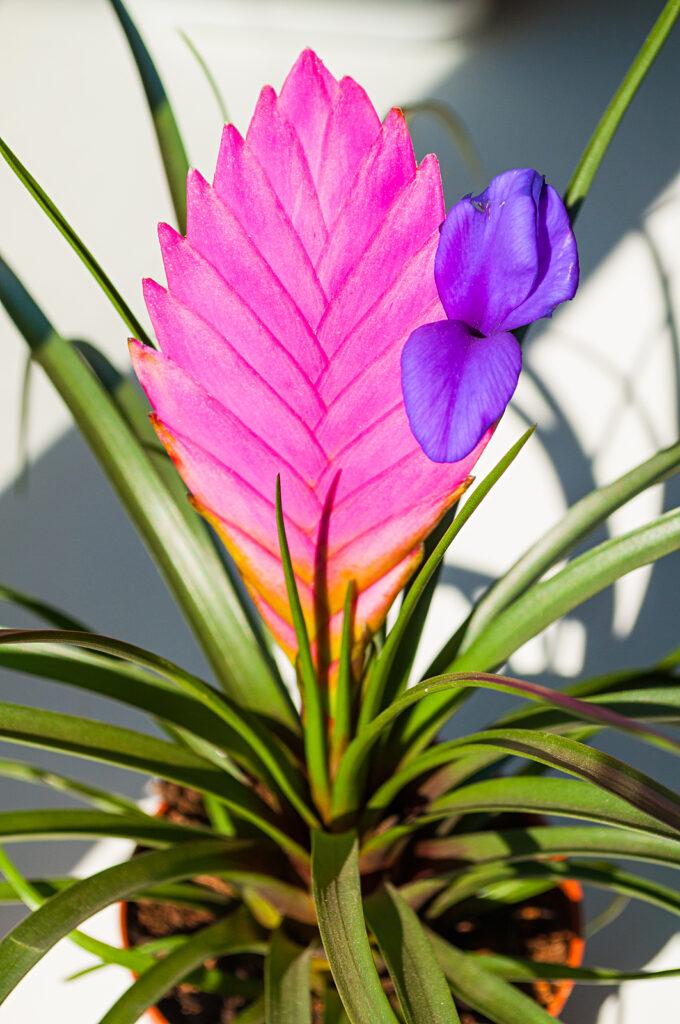Tillandsia is a genus of tree-dwelling (epiphytic) and terrestrial or rock-dwelling evergreen perennial bromeliads. They are mainly borne in rosettes. Most species have tubular to funnel-shaped flowers among colorful floral bracts.
Tillandsia are commonly grown in pots or as epiphytes on tree branches or slabs of bark. In some, leaf rosettes are bright green; in others, they are gray and scaly or scurfy. They are often mounted on plaques of wood or bark.
Tillandsia is a genus of more than 400 species. The best known is Spanish moss, T. usneoides. Tillandsia is native the southern United States, West Indies, and tropical Central and South America.
Get to know Tillandsia
- Plant type: Perennial bromeliad
- Growing zones and range: Zones 13-15
- Hardiness: Hardy to 45°F (7°C)
- Temperature: Tolerates 50° to 90°F (10° to 32°C) range, year-round.
- Height and width: 7 to 12 inches (18-30cm) tall, 6 to 12 inches (15-30cm) wide depending on the variety,
- Foliage: Often scaly leaves are star-shaped to narrowly triangular to linear, sometimes tapering to fine threads; borne in rosetts with long slender stems.
- Flowers: Tubular to funnel-shaped flwoers each with 3 sepals and 3 petals, often with spreading terminal lobes; borne usualy amoung colorful bracts
- Bloom time: Opening in daytime in spring or autumn
- Uses: on a bromeliad tree.
- Common name: Air plant, blue torch, Spanish moss
- Botanical name: Tillandsia
- Family name: Bromeliaceae
- Origin: Southern United States, West Indies, Central and South America

Where to plant Tillandsia
- Light: Bright light, direct sun from southern exposure. Air circulation is important.
- Light: Bright green varieties need filtered light; gray varieties can tolerate more sun.
- Soil: Mount on cork or slab of tree fern. Pot larger species in epiphytic bromeliad mix.
- Where temperatures fall below 45°F (7°C) grow as a houseplant or in a warm greenhouse.
- In subtropical and tropical regions grow outdoors on a tree or in a rock garden depending on speices; or grow on branches or bark placed on the ground.
When to plant Tillandsia
- Set Tillandsia outdoors in any region where temperatures do not fall below 45°F (7°C); otherwise, grow Tillandsia indoors.
Planting and spacing Tillandsia
- Space Tillandsia 6 to 12 inches (15-30cm) apart depending on the variety.
- Tillandsia prefers to be mounted on cork or a slab of tree fern bark, rather than being potted.
- If potted, plant Tillandsia in a bromelaid potting mix with the bases of the leaves at or just above the surface.
How to water and feed Tillandsia
- Water: Potted plants require only light watering. Mist plants that are not potted frequently. Humidity, 50% to 60%. Constant air circulation is essential.
- Let the potting mix dry between waterings.
- Bright green types need regular water; gray types need less water.
- Feeding: Monthly, with mild, half strength low-nitrogen liquid fertilizer. Avoid oil-based products such as fish emulsion.
Tillandsia care
- Tillandsia growth slows in winter; water sparingly.
- Tillandsia can be mounted on plaques of wood or bark and used as wall ornaments indoors or outdors (where hardy).
Growing Tillandsia as a houseplant
- Two species, Tillandsia caput-medusae, Medusa;’s head, and T. usneoides, Spanish moss, are grown as houseplants.
- Medusa’s head and Spanish moss need bright light, warm room temperature, and high humidity.
- Medusa’s head can be anchored to a slab of bark or grown in a pot. In a pot, use a peat-based soilless mix.
- Spanish moss can be anchored to tree bark or dropped over any structure to hang freely.
- The planting medium should be kept moist; to water mounted plants, submerge the bark slab in a sink or pail of water or mist twice a week.
- Medusa’s head can be fertilized once a month throughout the year.
Tillandsia pests and diseases
- Tillandsia is prone to Fusarium rot, scale insets, and mealybugs.
- Tillandsia is suscpetible to crown rot.
Tillandsia propagation
- Sow seed at 81°F (27°C) in spring onto sphagnum moss; mist daily.
- Detach offsets in spring.

Tillandsia varieties to grow
- Tillandsia bulbosa, dancing bulb. Grows to 9 inches (23cm) from a bulbous base; contorted branches extend outward and may have red or purple margins; blooms consist of red or green bracts with blue-purple flowers, appearing in fall.
- T. caput-medusae, Medusa’s head. Epiphyte grow 6 to 16 inches; dark green leaves; tubular blue flowers with red bracts.
- T. cyanea. Epiphytic perennials; stemless rosette of arching, dark green leaves with sharp edges; 8-inch (20cm) spike bears blue flowers and pink bracts; measures from 10 to 30 inches (25 to 76 cm) tall.
- T. ionantha, sky plant. Clustering epiphytic dwarf with pointed, silvery leaves arranged in a rosette; rosette center turns pink or red as violet flowers develop.
- T. lindenii, also listed as T. lindeniana, blue-flowered torch. Epiphytic perennial grows to 24 inch (61cm) tall; arching rosette of green leaves; deep blue flowers emerge from pink bracts in summer.
- T. setacea bears many thin, filamentlike leaves.
- T. usneoides, Spanish moss. Pendent, epiphytic perennial; rootless plant, with several feet of slender, silvery stems resembling lichen; in summer, pale green or blue flowers may appear.















